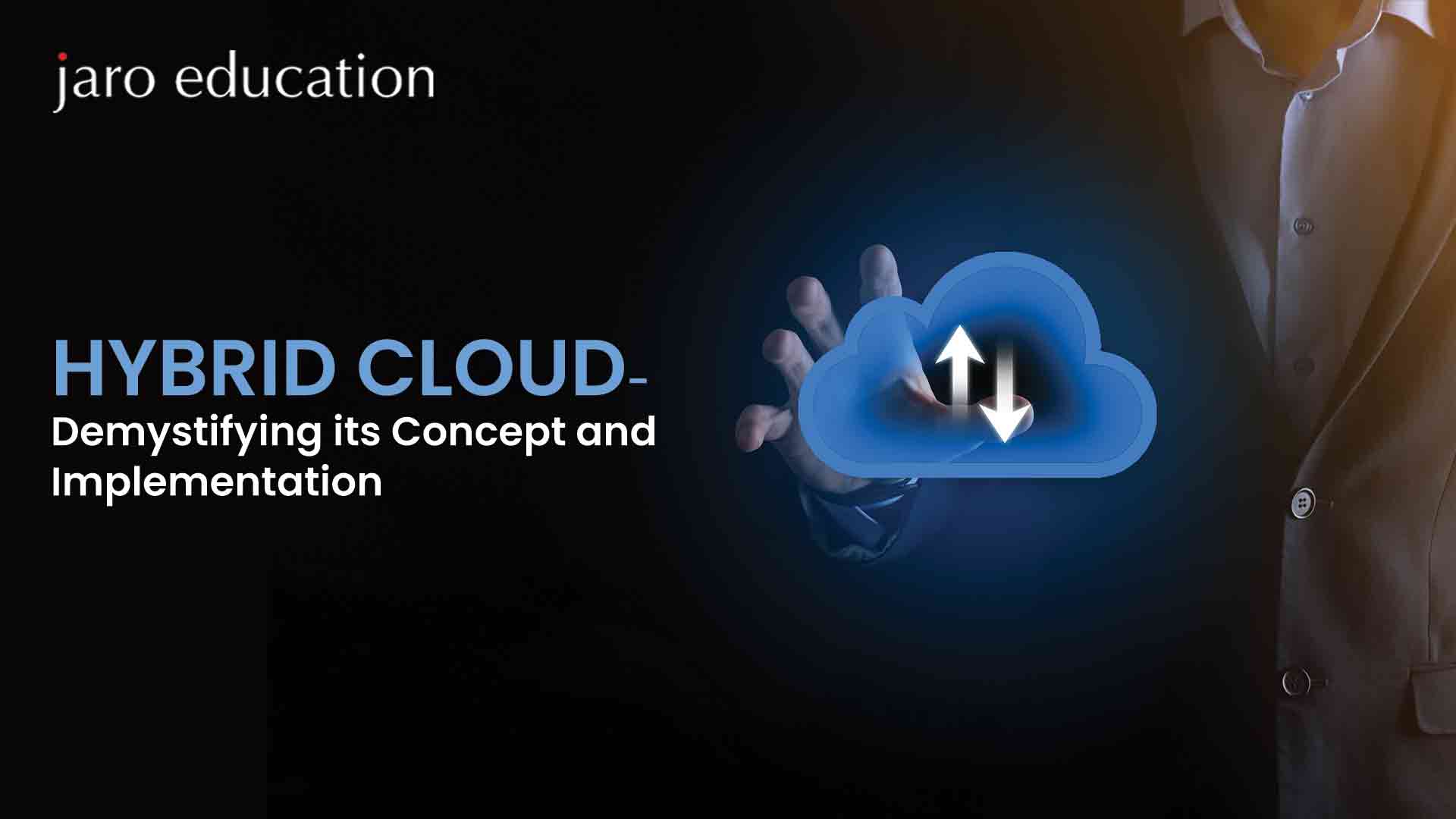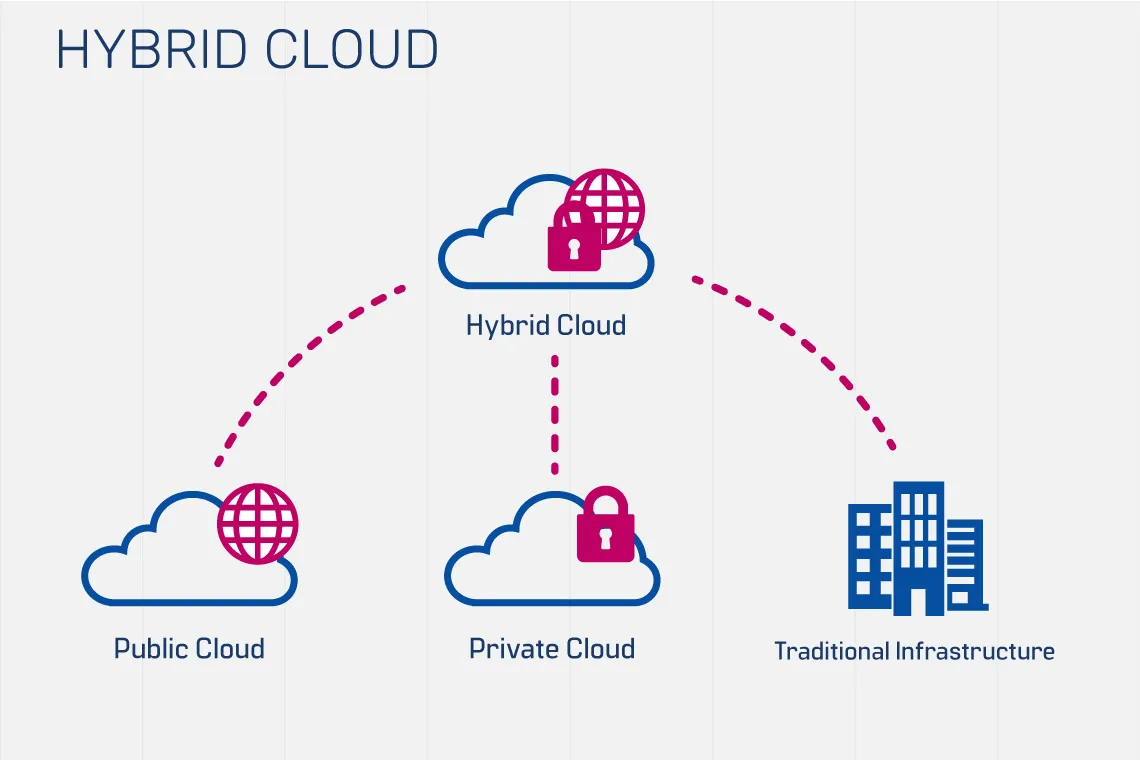Hybrid Cloud: Demystifying its Concept and Implementation
Table of Contents

- jaro education
- 2, May 2024
- 12:46 pm
Cloud computing is indispensable in modern IT infrastructure. It offers a forceful, resilient, and budget-friendly framework for data storage, application implementation, and service delivery. These days, the global landscape is experiencing a remarkable digital transformation, and in this changing scenario, the role of cloud computing has become quite significant. It boasts of being an invincible instrument that has successfully propelled organizations to revamp their IT infrastructures. Most modern business entities prefer cloud computing, which tends to reduce costs, broaden scalability, and amplify agility for a prosperous digital future.
Modern organizations frequently formulate unique strategies that cater to their specific demands. Hybrid cloud and multi-cloud strategy have become pivotal in this scenario. The following account will explain the hybrid cloud’s benefits, implementation, and possible challenges.
What is Hybrid Cloud?
The hybrid cloud combines the features of public cloud platforms like AWS with an establishment’s on-premise and private infrastructure. The aim is to create a compatible ecosystem to execute given tasks perfectly. This collaboration optimizes the workload and ensures that the assignments proceed seamlessly in the most favorable environment.
The implied adaptability of a hybrid cloud is itself a great attribute. Contemporary commercial organizations can access highly flexible computational resources their regular vendors provide to manage daily applications and pick workloads. Mission-critical operations provide sufficient protection within the purview of on-premises infrastructure. This strategic probability has privacy regulations and data security.

*cloudnowtech.com
Benefits of Hybrid Cloud Strategy
In the current ambiance of IT influence, digitization and operational efficacy are prime components for a business to flourish. The term hybrid cloud is frequently used in companies seeking to protect their operational obligations, where scalability, flexibility, and security are essential. The following are the hybrid cloud advantages and disadvantages that entrepreneurs should follow to combine the benefits of both public and private clouds:
- Cloud Bursting: The hybrid cloud inherits the ‘cloud bursting’ concept, an application deployment technique. The onus lies in an application operating within a data center or private cloud. However, as it pushes forward, it seamlessly ‘bursts’ into the gamut of the public cloud as the users locate a surge in computing demand. This unique strategy equips organizations to access on-demand facilities to gain additional computing resources when required.
- High Accessibility and Disaster Management: Business enterprises frequently control the power of hybrid clouds to strengthen their DR (Disaster Recovery) and HA (High Availability) competence. The prevailing setup ensures the recovery environment rests in the public cloud domain. In contrast, the production environment remains intact in the private cloud territory, ready to be activated promptly. The business data replicates itself in the public cloud for redundancy, leading to foolproof data security. Moreover, during normal operations, non-essential resources stick to the non-operational state until they are in demand.
Drawbacks of Hybrid Cloud Strategy
Modern business corporations and professionals must consider the successful integration of public and private clouds. For proper implementations, the users may face a few notable challenges, which are as follows:
- More Maintenance: Since a hybrid cloud is a blend of two solutions, it is more complicated than putting everything in the public cloud domain. In that case, the business owner has to pay the in-house staff to manage and safeguard private cloud data and software.
- Not Budget Friendly: Integrating a hybrid cloud may not be a better solution for small companies and startups, as it may impact the cost overheads. However, they can contemplate implementing it, provided they have security concerns.
- Requires Uninterrupted Internet Connection: You might lose track of remotely stored data when using a hybrid cloud solution. The situation may arise if your net connection suddenly fails. This situation can adversely impact your business activities if you solely rely on hybrid cloud performance. The ideal consideration should be to treat this solution as one of several options the company management should consider in the future with continuity planning.
Implementing a Hybrid Cloud Strategy
Users must set up a systematic approach to implement a hybrid cloud strategy. Here are some selective steps a rational business should follow to adopt the process effectively:
- Evaluation of Existing Infrastructure and Workloads
This evaluation aspect is a crucial starting point for the voyage to a hybrid cloud variation. The scenario integrates defining parameters that transform a service into a candidate for cloud migration. The after-effect is a detailed study of the prevailing on-premise infrastructure.
- Analysis of On-Premises Infrastructure
Users should begin by examining on-premises infrastructure, which assembles storage systems, servers, datasets, and networking tools. They must assess these ingredients’ capacity, age, security angles, and performance and explore areas where upgrades are paramount to confirm compatibility with cloud services.
- Identification of Workload for Migration
Not all workloads benefit from migration to the cloud. Prioritizing workloads based on scalability, data sensitivity, and performance requirements helps. For specific workloads, consider a lift-and-shift approach.
- Identifying Requirements and Setting Goals
You must set clear objectives and essential requirements for an effective hybrid cloud strategy. These requirements may include scalability, cost reduction, enhanced agility for disaster recovery, compliance and shared responsibility.
- Selection of Dependable Cloud Providers
Verifying and selecting reliable cloud providers is instrumental in developing an ideal hybrid cloud strategy. When evaluating, you should consider pricing models, service offerings, SLAs (Service Level Agreements), and global reach. Confirming seamless integration between cloud environments and on-premises is mandatory and should be compatible. Also, you must ensure the selected service provider has the necessary tools, device connections, and APIs to discharge foolproof workload and data migration.
- Designing the Hybrid Cloud Architecture
Implementing a successful cloud strategy depends on designing a robust hybrid cloud architecture. It depends on a well-planned topology that complies with the existing business objectives and requirements. The hybrid cloud architecture should include data flows, network topology, and IAM (Identity and Access Management). Besides, establishing secure networking solutions emphasizing connectivity between on-premises and cloud locations is necessary. The available technologies are VPN (Virtual Private Network) and direct connections such as Azure ExpressRoute or AWS Direct Connect.
- Migration of Defined Workloads
Workloads should be migrated to the cloud according to the defined goals and needs of the hour. The approach leading to migration can fluctuate depending on the workload category, namely lift and shift, with minimal modifications and refactoring that may include containerization or serverless computing. A hybrid environment necessitates deploying relevant tools for workload management, orchestration, monitoring, and analytics. Harnessing these tools facilitates improved control and visibility across hybrid cloud infrastructure.
- Ensuring data security and Compliance
Data protection during transit and at rest is paramount. Users must implement encryption mechanisms such as TLS/SSL for encryption and data in transit at the storage layer for static data. They must also ensure access controls and role-based allowances to restrict data access to competent authorities.
Different industries have their in-house compliance requirements crafted for suitability. Business owners in sectors like healthcare, finance, or other regulated industry segments should ensure the newly inducted hybrid cloud solutions are compatible with industry-specific requirements. The key to success is a regular audit of the compliance measures to stay updated with evolving standards.
- Optimisation and Testing Rituals
The scenario about testing and optimization phases is critical to confirm that hybrid cloud environments are revamped for efficiency and peak performance. This correspondingly maximizes the advantages of cloud elements and on-premises. Detailed testing is compulsory for earmarking and addressing prospective problems before adversely impacting operations. Test scenarios should include performance testing, resource scaling, and disaster recovery for data integrity.
Resource optimization is a crucial activity based on real-world usage patterns. It saves costs and improves performance. Users should use analytics and monitoring tools to explore the scope of resource utilization and adjust resource allocation according to a given situation.
- Monitoring and Managing the Operations
Constructive monitoring and management skills are crucial for retaining a business cloud environment’s health and performance parameters. For that, one must implement monitoring tools that provide visibility into both on-premises and hybrid cloud workloads. These significant tools allow issue detection proactively and arrive at a prompt resolution.
The principal monitoring metrics are memory usage, CPU utilization, security events, and network traffic. The users must identify incident response protocols to resolve security and performance issues and downtime without wasting time. A well-defined plan and layout reduces bottlenecks and revives business continuity. Routine checks and updates regarding protocols help corporate heads stay prepared for emerging threats.
Hybrid Cloud - Example
Every industry across the globe can migrate to a hybrid cloud environment. Here is a hybrid cloud example related to the insurance sector. An insurance service provider (company) may seek and utilize services from different cloud providers for diverse functions and objectives. These may comprise:
- AWS (for data preservation)
- Azure (for customer analytics and CRM goals)
- Google Clouds for AI-driven applications
Any company can manage these critical services successfully with the element of shared responsibility. This, on the other hand, may lead to rendering high-quality, personalized, and timely services to clients to boost ROI.
Conclusion
Professionals and aspirants aiming to settle for a balanced approach regarding cloud computing will feel that it is the linchpin of today’s IT infrastructure. The migration towards hybrid and multi-cloud environments has the positive traits of agility, cost efficiency, scalability, interoperability, security, and high-end innovation.
The remarkable evolution of the digital landscape and the significance of cloud computing have emerged and will stay for a long time. Hybrid clouds logically and seamlessly combine public and private cloud concepts to produce optimal workload performance. Additionally, hybrid cloud strategies offer control, flexibility and geographical gains that mitigate outages and vendor lock-ins.
If you want to unravel the concept of hybrid cloud further, you can opt for the Online Master of Computer Applications conducted by Chandigarh University. It is a two-year postgraduate degree course that is tailored to meet the exact requirements of IT professionals. It prepares the students who aspire to pursue their careers in the IT domain and become successful in their endeavors. It helps them understand diverse tools and programming languages. Besides, these skills also assist them in developing superior and faster applications that align with prevailing industry standards.







